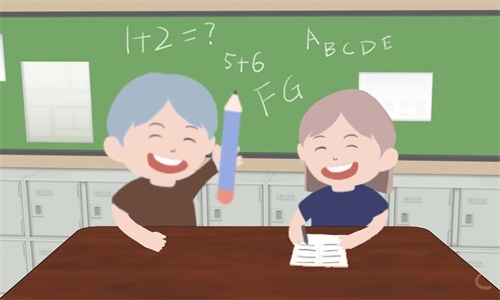初一英语上册知识点人教版5篇
相关文章
虽然在学习的过程中会遇到许多不顺心的事,但古人说得好——吃一堑,长一智。多了一次失败,就多了一次教训;多了一次挫折,就多了一次经验。下面是小编为大家精心整理的初一英语上册知识点人教版,希望对大家有所帮助。

初一英语上册知识点人教版1
1.There is +单数可数名词/不可数名词+ 地点状语.
There are +复数名词+地点状语.
谓语动词要与跟它最近的那个名词一致(就近原则)。
There be句型的否定式在be后加上not或no即可。
注意not和no的不同:not是副词,no为形容词,not a/an/any + n. 相当于no+ n.
There be句型的一般疑问句变化是把be动词调整到句首
There be表示“某处存在某物或某人”;have表示“某人拥有某物/某人”
2.问路:
①Is/ Are there ……near here/ around here/ in the neighborhood?
②Where is/ are……?
③How can I get to……?
④Could/Can you tell me the way to……
⑤Which is the way to……
3.Across,cross,through,over
Across是介词,“横过,在对面”表示从物体表面穿过
Cross是动词,相当于go/ walk across
Through是介词,表示从物体中间或里面穿过 go through the door
Over是介词,“横过,越过”表示从物体上空越过,跨过 fly over
4.ask for help/ advice
5.in/ on the street
6.在某条大街上习惯用介词on on Bridge Street
7.across from,next to,between…and…,behind
8.in front of在…(外部的)前面→behind在…后面 in the front of在…(内部的)前面
9.be in town→be out of town
10.be far from
11.go/ walk along go straight go up/ down
12.turn left/right
13.on one’s/ the left
14.at the first crossing/ turning
15.sometimes 有时(频度副词)
ometime(将来)有朝一日,(曾经)某天
ome times 几次,几倍 some time 一段时间(前面用介词for)
16.free
空闲的 free time
自由的 as free as a fish
免费的 The best things in life are free.
17.enjoy doing
18.Time goes quickly.
19.表“一些”在肯定句中用some. 在疑问句和否定句中用any。
特殊用法:some可用于表示盼望得到对方肯定的答复或表示建议、委婉请求的疑问句中。
any也可用于肯定句中,表示"任何的"。
初一英语上册知识点人教版2
1、三种人称:第一人称(I, we),第二人称(you, you),第三人称(he, she, it, Maria)。
2、人称代词的主格,即人称代词位于句子主语位置时的形态:I, We, You, You, He, She, It, Maria。
3、人称代词的宾格,即人称代词位于句子宾语位置时的形态:me, us, you, you, him, her, it。
4、形容词性物主代词:my, our, your, your, his, her, its, their。
5、名词性物主代词:mine, ours, yours, yours, his, hers, its, theirs。
6、反身代词:myself, ourselves, yourself, yourselves, himself, herself, itself, themselves。
初一英语上册知识点人教版3
不定冠词a和an
a和an都是不定冠词,表示一(个,支,本,块……)的意思,但不强调数量概念,而是强调类别,用来限定名词。a用在辅音音素开头的单数名词前,如:a pencil(一支铅笔),a book(一本书);an用在元音音素开头的名词前,如an eraser(一块橡皮)。如果名词前有修饰语,用a还是用an,则以该修饰语的第一音素决定用a还是用an。如:
a clock 一座钟
an old clock 一座旧钟
a book 一本书
an English book 一本英语书
a nice apple 一个可爱的苹果
an apple 一个苹果
初一英语上册知识点人教版4
(1)this和that是指示代词,it是人称代词。
(2)距离说话人近的人或物用this, 距离说话人远的人或物用that。
如: This is a flower. 这是一朵花。(近处)That is a tree. 那是一棵树。(远处)
(3)放在一起的两样东西,先说this, 后说that。
如: This is a pen. That is a pencil. 这是一支钢笔。那是一支铅笔。
(4)向别人介绍某人时说This is…, 不说That is…。
如:This is Helen. Helen, this is Tom. 这是海伦,海伦,这是汤姆。
(5)This is 不能缩写, 而That is可以缩写。
如: This is a bike. That’s a car. 这是一辆自行车。那是一辆轿车。
(6)打电话时,介绍自己用this, 询问对方用that。
如: —Hello! Is that Miss Green? 喂,是格林小姐吗? —Yes, this is. Who’s that? 是的,我是,你是谁?
注意:虽然汉语中使用“我”和“你”,但英语中打电话时绝不可以说:I am…, Are you…?/Who are you? (7)在回答this或that作主语的疑问句时, 要用it代替this或that。
如: ①—Is this a notebook? 这是笔记本吗?—Yes, it is. 是的,它是。
②—What’s that? 那是什么?—It’s a kite. 是只风筝。
初一英语上册知识点人教版5
Unit 5
1.回答why的提问要用because
2.Kind of 相当于副词,修饰形容词或副词,意为“稍微,有点”,与a little/ bit 相近
A kind of 意为“一种”,some kinds of 意为“几种”,all kinds of 意为“各种各样的”。这里的kind 是“种,类,属”的意思。
3.Why not =Why don’t you+V原 你为什么不…?
4.walk on one’s legs/ hands
on 意为“用…方式行走”
5.all day =the whole day整天
6.来自be/ come from
where do they come from?
=where are they from?
7.more than=over超过 less than 少于
8.once twice three times
9.be in great danger
10.one of… …之一 +名词复数
11.get lost
12.with/ without 有/ 没有 介词
13.a symbol of
14.由…制造 be made of能看出原材料
e made from 看不出原材料
e made in+地点 表产地
15.cut down 砍到
动副结构(代词必须放中间,名词可放中间或者后面)
Unit 6
1.现在进行时
其结构为be的现在式(am, is, are)+ 现在分词(V-ing)。
否定形式在be后面加not,疑问式将be动词提前
2.动词-ing形式的构成:
一般情况+ing;以不发音的e结尾的,去e加ing;重读闭音节结尾,末尾只有一个辅音字母,双写辅音字母再加ing
3.go to the movies
4.join sb for sth与某人一起做某事
join us for dinner
5.live with sb
live in+地点
6.other,another与the other
Other “其他的,另外的”,后接名词复数,有时other+n复数=others
Another “又一(个),另一(个)”,泛指总数为三个或三个以上中的任意一个,后接名词单数。
The other“(两者中的)另一个”,常与one连用,“one…the other…”表示“一个…,另一个…”
7.talk on the phone
8.wish to do sth
9.Here is+ n单
Here are+ n 复
Unit 7
1.询问天气的表达方式:
How’s the weather?
It’s a raining/sunny day.
It’s raining.
What’s the weather like?
It’s windy.
2.play computer games
3.How’s it/ everything going?
4.In/ at the park
5.Take a message for sb 替人留言
Leave a message to sb 给人留言
6.call sb back
7.right now,right away,at once,in a minute,in a moment,in no time 立刻,马上
8.right now现在
just now刚刚(用于一般过去式)
9.over and over again
10.the answer to the question,a key to the door,a ticket to the ball game
11.by the pool
12.summer vacation
13.go on a vacation去度假
e on a vacation在度假
14.write (a letter)to sb
15.反意疑问句(陈述句+附加疑问句)
反意疑问句中,陈述句用的肯定,后面的附加疑问句就要用否定;相反,陈述句用的否定,附加疑问句就要用肯定。
16.以-ing结尾“令人…的”exciting,interesting,relaxing
以-ed结尾“人感到…的”excited,interested,relaxed
17.in the first picture
18.dry干燥的 humid潮湿的
Unit 8
1.There is +单数可数名词/不可数名词+ 地点状语.
There are +复数名词+地点状语.
谓语动词要与跟它最近的那个名词一致(就近原则)。
There be句型的否定式在be后加上not或no即可。
注意not和no的不同:not是副词,no为形容词,not a/an/any + n. 相当于no+ n.
There be句型的一般疑问句变化是把be动词调整到句首
There be表示“某处存在某物或某人”;have表示“某人拥有某物/某人”
2.问路:
①Is/ Are there ……near here/ around here/ in the neighborhood?
②Where is/ are……?
③How can I get to……?
④Could/Can you tell me the way to……
⑤Which is the way to……
3.Across,cross,through,over
Across是介词,“横过,在对面”表示从物体表面穿过
Cross是动词,相当于go/ walk across
Through是介词,表示从物体中间或里面穿过 go through the door
Over是介词,“横过,越过”表示从物体上空越过,跨过 fly over
4.ask for help/ advice
5.in/ on the street
6.在某条大街上习惯用介词on on Bridge Street
7.across from,next to,between…and…,behind
8.in front of在…(外部的)前面→behind在…后面 in the front of在…(内部的)前面
9.be in town→be out of town
10.be far from
11.go/ walk along go straight go up/ down
12.turn left/right
13.on one’s/ the left
14.at the first crossing/ turning
15.sometimes 有时(频度副词)
ometime(将来)有朝一日,(曾经)某天
ome times 几次,几倍 some time 一段时间(前面用介词for)
16.free
空闲的 free time
自由的 as free as a fish
免费的 The best things in life are free.
17.enjoy doing
18.Time goes quickly.
19.表“一些”在肯定句中用some. 在疑问句和否定句中用any。
特殊用法:some可用于表示盼望得到对方肯定的答复或表示建议、委婉请求的疑问句中。
any也可用于肯定句中,表示"任何的"。


